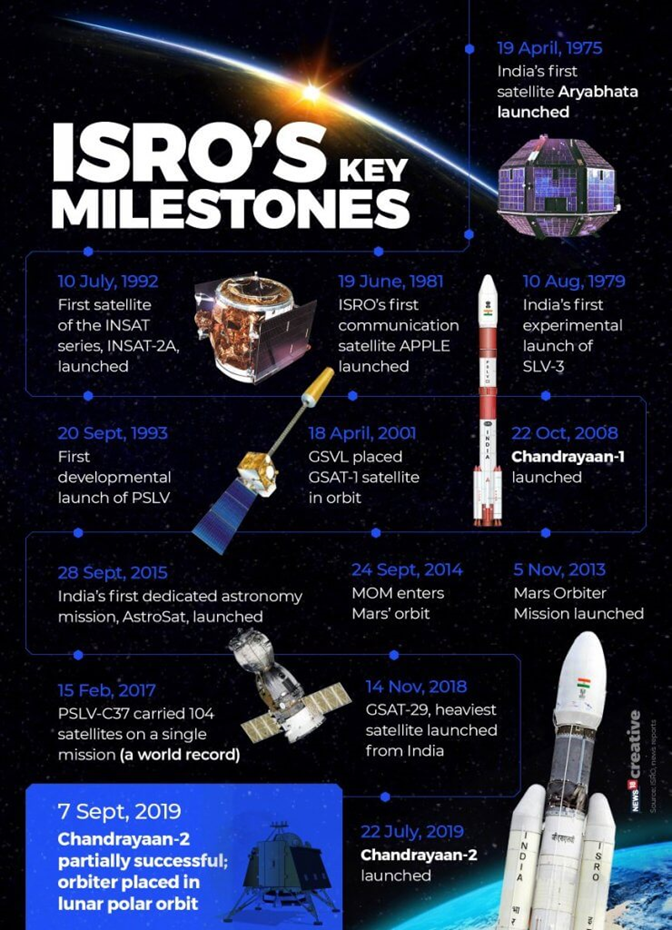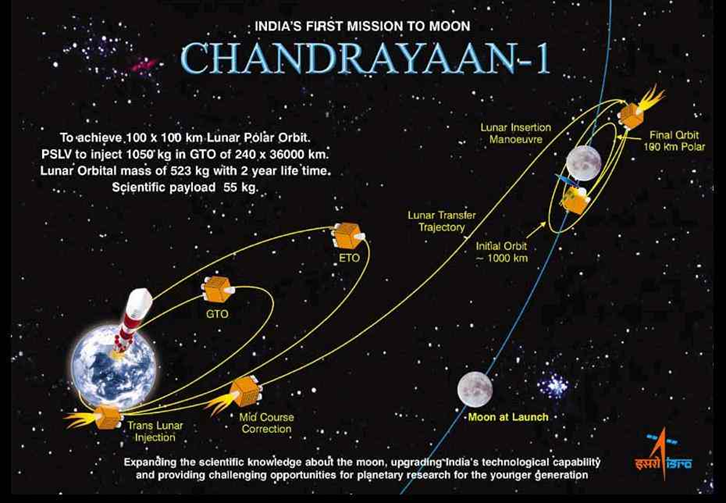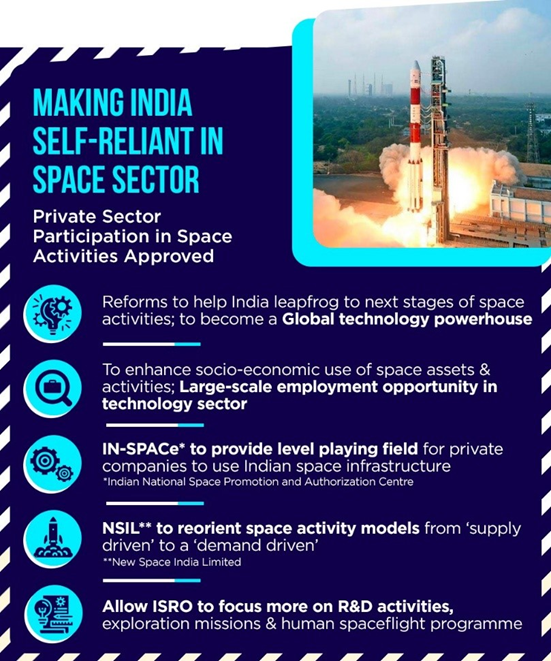Introduction
- Space technology refers to the technologies developed for the purpose of exploring and utilizing space. It includes a wide range of technologies used in space missions, including spacecraft design, propulsion systems, communication systems, navigation systems, remote sensing and observation systems, and life support systems.
- Space technology also includes the development of various ground-based facilities, such as launch facilities, tracking and control centers, and research facilities.
- The application of space technology has led to significant advances in our understanding of the universe, as well as in various industries, including communication, navigation, weather forecasting, agriculture, and defense.
Indian Space Technology Sector
The Indian space technology sector has seen significant growth and development over the past few decades, with the Indian Space Research Organisation (ISRO) at the forefront of the country’s space program.
- Launches: As of March 2021, ISRO has conducted a total of 82 spacecraft launches, including satellites, space probes, and experimental payloads. These launches have included successful missions to the moon and Mars, as well as numerous communication and remote sensing satellites.
- Satellites: ISRO has developed a range of satellite technologies, including communication, remote sensing, navigation, and weather forecasting. Some notable examples include the Indian Remote Sensing (IRS) series of satellites, which provide high-resolution imagery for a variety of applications, and the Indian Regional Navigation Satellite System (IRNSS), which provides positioning, navigation, and timing services to users in India and neighboring countries.
- Commercialization: ISRO has been actively working on commercializing its space technologies and services, with a particular focus on remote sensing and communication services. For example, ISRO has signed agreements with several private companies to provide remote sensing data for agriculture, forestry, and disaster management applications. In 2020, ISRO launched its first dedicated commercial satellite, carrying 19 satellites for the US and other countries.
- Budget: The budget for ISRO has steadily increased over the years, indicating the Indian government’s commitment to investing in the space technology sector. In 2021, the budget for ISRO was increased to Rs. 13,949 crore ($1.9 billion), a 9.4% increase from the previous year.
- International collaborations: ISRO has collaborated with several international space agencies, including NASA, the European Space Agency (ESA), and the Russian Federal Space Agency (Roscosmos). For example, ISRO and NASA collaborated on the Mars Orbiter Mission (MOM) and the Chandrayaan-1 moon mission.
- Spin-off technologies: The Indian space program has led to the development of several spin-off technologies that have applications in various industries. For example, ISRO’s lithium-ion battery technology is being used in electric vehicles, while its remote sensing technologies are being used for agriculture and disaster management.
Applications of space technology in India are:
- Communication: India has a wide network of communication satellites in orbit which provide connectivity to remote areas of the country. The Indian National Satellite System (INSAT) provides services like television broadcasting, telemedicine, and disaster management. Example: GSAT series satellites of India.
- Remote Sensing: India has a fleet of earth observation satellites that provide high-resolution images of the Earth’s surface for various applications like land use mapping, resource management, and environmental monitoring. Example HySIS satellites.
- Navigation: The Indian Regional Navigation Satellite System (IRNSS) provides precise positioning and timing information to users in India and the surrounding regions.
- Weather Forecasting: India’s meteorological satellites provide real-time weather data, which helps in accurate weather forecasting and disaster management.
- Agriculture: The data obtained from earth observation satellites is used for crop monitoring and assessment, soil moisture estimation, and drought prediction. Example: KISANSAT.
- Disaster Management: The satellite data is used for disaster management during natural disasters like floods, earthquakes, and cyclones. The National Remote Sensing Centre (NRSC) plays a vital role in this regard. Example: Data released on Joshimath sinking by ISRO
- Defence: The Indian Space Research Organisation (ISRO) provides satellite-based services to the Indian Defence forces for surveillance, reconnaissance, and communication. Example: RISAT satellites
Major achievements of the Indian space sector

India has made significant achievements in space exploration and technology since the establishment of the Indian Space Research Organisation (ISRO) in 1969. Some major achievements of the Indian space sector:
- Launch of Chandrayaan-1: In 2008, India’s first lunar mission, Chandrayaan-1, was launched, making India the fourth country to send a spacecraft to the moon.

- Launch of Mars Orbiter Mission: In 2013, India successfully launched the Mars Orbiter Mission (MOM) spacecraft, which reached Mars’ orbit in September 2014. This made India the first country in the world to successfully enter the Martian orbit on its first attempt.
- Development of GSLV: The Geosynchronous Satellite Launch Vehicle (GSLV) was developed indigenously by ISRO and has been used to launch several communication satellites.
- Launch of the IRNSS: The Indian Regional Navigation Satellite System (IRNSS) is a constellation of satellites that provides accurate positioning and timing services to India and its neighboring countries.
- Launch of South Asian Satellite: In May 2017, India launched the South Asian Satellite (SAS), a communication satellite designed to provide communication and broadcasting services to South Asian countries.
- Launch of PSLV-C51: In February 2021, ISRO successfully launched PSLV-C51 carrying Amazonia-1 and 18 other co-passenger satellites.
- Human Spaceflight program: ISRO is working on its first Human spaceflight mission called Gaganyaan Mission to send 3 indians into space in next 2 years.
Issues with Indian space sector
- Funding: According to the Union Budget for 2021-22, the Department of Space was allocated Rs 13,949 crore ($1.9 billion), which is just 0.46% of the total Union Budget. In comparison, NASA’s budget for 2021 is $25.2 billion. This shows that the Indian space sector receives relatively low funding compared to its counterparts in developed countries.
- Technology: While India has made significant progress in developing indigenous technologies, it still relies heavily on foreign technology. For example, the Indian Geostationary Satellite Launch Vehicle (GSLV) uses a Russian-made cryogenic engine. In addition, the Indian space sector faces challenges in developing cutting-edge technologies such as reusable launch vehicles and spaceplanes.
- Human resources: According to a report by the Confederation of Indian Industry (CII), the Indian space industry faces a shortage of skilled workers in areas such as satellite manufacturing, launch vehicle design, and propulsion systems. The report also states that there is a lack of specialized training programs to address this skill gap.
- Private sector participation: The Indian space industry is dominated by the government-run Indian Space Research Organization (ISRO). According to a report by FICCI, the private sector accounts for only about 6% of the total space industry revenue in India. This is in contrast to the US, where private companies such as SpaceX and Blue Origin play a significant role in the space sector.
- Regulatory framework: The Indian space industry lacks a comprehensive regulatory framework that can facilitate private sector participation while ensuring safety and security. According to a report by the Observer Research Foundation, the existing regulatory framework is fragmented and lacks clarity on issues such as licensing, liability, and intellectual property rights.
- International competition: India faces stiff competition from established players such as the US, Russia, and China, as well as emerging players like Japan, South Korea, and Israel. For example, China has launched several missions to the Moon and Mars in recent years, while SpaceX has successfully launched reusable rockets and is working on a mission to Mars.
Role for Private Sector in Indian space market
- The global space economy is currently valued at about USD 360 billion. Despite being one among a few spacefaring nations in the world, India accounts for only about 2% of the space economy. Over the last 2 decades, the private sector has played an increasingly important role in other spacefaring countries within the global space economy.
- Companies like SpaceX, Blue Origin, Virgin Galactic, and Arianespace have revolutionized the space sector by reducing costs and turnaround time, with innovation and advanced technology. In India however, players within the private space industry have been limited to being vendors or suppliers to the government’s space program.
- Thus, there was a need to provide scope for Non-Governmental Entities (NGEs) for enhanced participation in Indian space programme and playing key roles to boost India’s market share in Global Space Economy.

GUIDING PRINCIPLES OF REFORMS
- Open up ISRO Infrastructure and Facilities The reform also aims to make national space infrastructure developed over the years, available for use by the private industry through a business friendly mechanism.
- Enable and promote Non-Governmental Entities (NGE) to carry out independent space activities Provide a level playing field and favorable regulatory environment for players within the Indian private sector, to allow them to become independent actors in the space sector instead of being solely vendors or suppliers to the government program.
- Demand-driven approach for development of space assets Optimizing the utilization of space assets such as satellites and launch capacity by determining accountability amongst various stakeholders. Creation of new assets to be made contingent on confirmation of demand from user agencies/ entities.
- Public sector to enable Transfer of Technology to Industries Clear guidance has been provided that public sectors in the space domain will focus on enabling transfer of matured technologies to industries to avoid reinvention of wheel. industry can approach IN-SPACe for obtaining new technologies in the space domain.
Steps taken in this direction
- SETTING UP OF IN-SPACE: To facilitate private sector participation, the government has created the Indian National Space Promotion and Authorization Centre (IN-SPACe), as a single window, independent, nodal agency under Department of Space. Its main mandate is to promote and enhance the role of Non-Government Entities (NGEs) in the space sector through hand holding, support, and by providing them with a level playing field. It will also authorize the use of ISRO facilities by private companies, development of Indian satellite systems, and launch of rockets/ vehicles developed by the private sector.

- Provide a stable regulatory and policy environment: The reforms have strengthened the policymaking capacity of the Department of Space and an exercise has been initiated to create new business-friendly policy framework for Space sector covering remote sensing, satellite communication, navigation, technology transfer, space transportation, space situational awareness, human space flight, etc. The draft space policy has been reviewed by Space Commission and consultation with industry & inter-ministries completed. The updated space policy has been submitted for approval of government.
- Enhancing The Role Of New Space India Ltd: The reforms have authorized the public sector company NSIL to act as the exclusive public-sector aggregator for both demand and supply of space assets/ services on a commercial basis, including imaging, communication transponders, launch services etc. In its role as a demand aggregator, NSIL will acquire satellites, launch vehicles, and other assets developed by ISRO or the private industry. In its role as a supply aggregator, NSIL will commercialize assets and services like transponder capacity, imaging services, launch capacity etc, on ISRO-developed satellites and launch vehicles.
IMPACT OF REFORMS
- Industries, start-ups, and academia have warmly welcomed the space sector reforms, and the new IN-SPACe mechanism.
- More than 150 proposals from start-ups, MSMEs and industries have already been received for future consideration by IN-SPACe, illustrating the overwhelming response to the system.
- PSLV private Production: One of the major breakthrough in the commercialization is PSLV production through Industry. NSIL and HAL exchanged the MOU for producing 5 nos. of PSLVs . L&T is partnering with HAL in the consortium.
- Private Launch Vehicles development: Skyroot Aerospace, India’s space tech startup successfully launched Vikram-S first maiden flight from Sriharikota on 18th November,2022. This mission named as “PRARAMBh”, which is the first private rocket launch mission in the country authorised through IN-SPACe mechanism. Vikram-S is a single stage solid fueled, sub-orbital rocket manufactured using advanced technologies including carbon composite structures and 3D printed components.
Other initiatives of ISRO
- YUva VIgyani KAryakram (YUVIKA-2022) :YUVIKA is a two weeks residential programme organized at five ISRO centres which includes teaching and practical exposure to students in the 9th standard. 153 nos. of students from 36 states/UTs participated in the programme.
- UNNATI (Unispace Nano Satellite Assembly & Training by ISRO): UNNATI is a capacity building programme, it is a training on combination of theoretical course work and hands-on training on assembly, integration and testing of nano satellites for the foreign participants. ISRO had trained 60 participants from 33 countries in two batches and third batch training is in progress.
- Space Tutor Space Tutor: is a collaborative programme between ISRO and NGOs/Start-ups/Institutions involved in promoting space education & STEM activities. 56 space tutors are registered across the country.
- Human Resource Development: ISRO and Ministry of Skill Development & Entrepreneurship (MSDE) has launched a skill development programme in the space domain. 40 young professional from across the country and 100 ISRO staff were trained in the last 2 months at National Skill Training Institutes (NSTI) under MSDE. This Programme will continue every month for imparting skilled courses for ISRO Staff.



